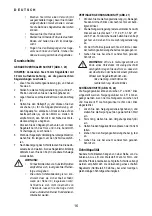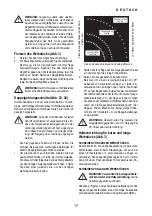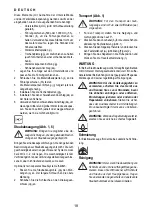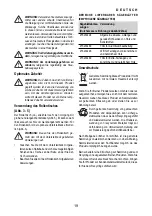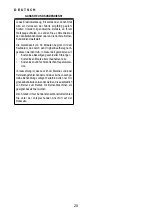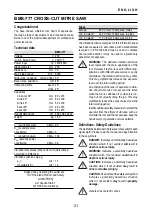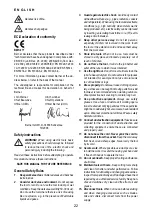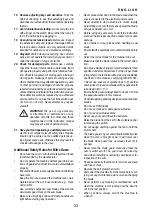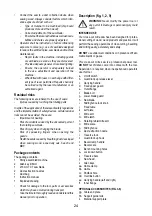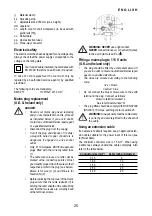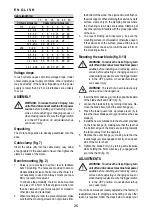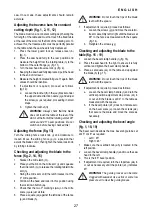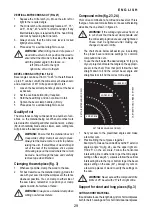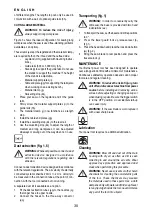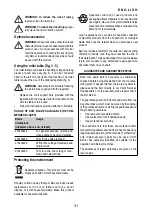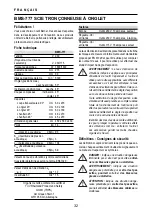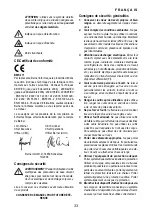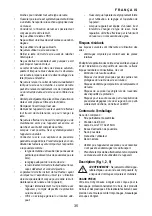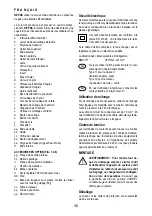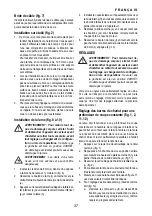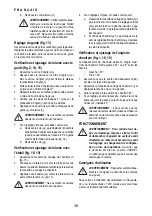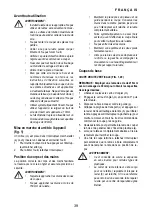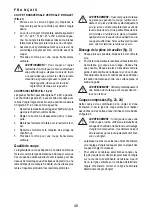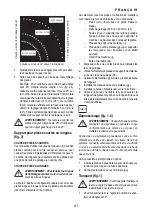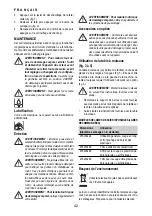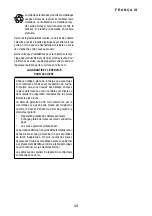
28
E N G L I S H
OPERATION
WARNING: To reduce the risk of injury, turn
unit off and disconnect machine from power
source
before installing and removing acces-
sories, before adjusting or changing set-ups or
when making repairs. Be sure the trigger switch
is in the OFF position. An accidental start-up
can cause injury.
Instructions for use
WARNING:
Always observe the safety instruc-
tions and applicable regulations.
The attention of UK users is drawn to the “woodwork-
ing machines regulations 1974” and any subsequent
amendments.
Prior to operation
WARNING:
•
Install the appropriate saw blade. Do not
use excessively worn blades. The maxi-
mum rotation speed of the tool must not
exceed that of thesaw blade.
•
Do not attempt to cut excessively small
pieces.
•
Allow the blade to cut freely. Do not
force.
•
Allow the motor to reach full speed before
cutting.
•
Make sure all locking knobs and clamp
handles are tight.
•
Secure the workpiece.
•
Although this saw will cut wood and many
nonferrous materials, these operating
instructions refer to the cutting of wood
only. The sameguide-lines apply to the
other materials. Do not cut ferrous (iron
and steel) materials or masonry with this
saw! Do not use any abrasive discs!
•
Make sure to use the kerf plate. Do not
operate the machine if the kerf slot is wider
than 10 mm.
•
Placing the workpiece on a piece of wood
will increase the capacities to 300 mm.
Switching on and off (fi g. 1)
A hole (cc) is provided in the on/off switch (a) for insertion
of a padlock to lock the tool.
1. To run the tool, press the on/off switch (a).
2. To stop the tool, release the switch.
Body and hand position
Proper positioning of your body and hands when operat-
ing the mitre saw will make cutting easier, more accurate
and safer.
WARNING:
•
Never place your hands near the cutting
area.
•
Place your hands no closer than 150 mm
from the blade.
•
Hold the workpiece tightly to the table and
the fence when cutting. Keep your hands in
position until the switch has been released
and the blade has completely stopped.
•
Always make dry runs (without power)
before fi nish cuts so that you can check
the path of the blade.
•
Do not cross your hands.
•
Keep both feet firmly on the floor and
maintain proper balance.
•
As you move the saw arm left and right,
follow it and stand slightly to the side of
the saw blade.
Basic saw cuts
VERTICAL STRAIGHT CROSS CUT (FIG. 1, 20)
NOTE: Use 216 mm saw blades with 30 mm arbor holes
to obtain the desired cutting capacities.
1. Slacken the mitre latch (m) and subsequently lift it
up.
2. Engage the mitre latch (m) at the 0° position and
fasten the mitre latch.
3. Place the wood to be cut against the fence (p).
4. Take hold of the carrying handle (c) and press the
guard lock up release lever (b) to release the guard.
Press the trigger switch (a) to start the motor. It is
recommended to start the cut near the fence.
5. Depress the head to allow the blade to cut through
the timber and enter the plastic kerf plate (k).
6. When the head is fully depressed, slowly pull it across
to complete the cut.
7. After completing the cut, release the switch and wait
for the saw blade to come to a complete standstill
before returning the head to its upper rest position.
WARNING:
•
For some types of plastic profi les, it is
advisable to follow the sequence in reverse
order.
•
The lower blade guard is designed to close
quickly when the lever (b) is released. If it
does not close within 1 second, have the
saw serviced by an authorized Berner
repair agent.



